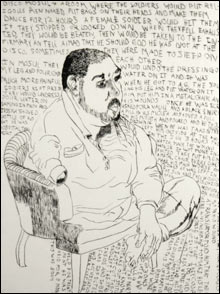
DANIEL HEYMAN: Disco Mosul |
The photographs of grotesque prisoner abuses at Abu Ghraib, so shocking when they surfaced two years ago, have since been reproduced so many times that their power to devastate has diminished. Horrific as the images are, by now they’re almost clichés. Which is why it’s so jarring to look at Provincetown artist Daniel Heyman’s watercolors and drypoint prints, on display this month at the Schoolhouse Gallery in Provincetown.
In March, Heyman — who teaches at Rhode Island School of Design and the Tyler School of Art — was invited to Amman, Jordan, by Burke Pyle, LLC, which is helping to gather evidence for a class-action lawsuit on behalf of Abu Ghraib detainees. Heyman sat in with American Prospect senior editor Tara McKelvey while she interviewed former prisoners. He set to work, using a metal stylus to etch the detainees’ portraits into a copper plate, and then filled the space around their faces with words. The nature of the printmaking process required him to write backward. In the words crowded around the images, every once in a while there is a misprint, which, in a way, helps convey the immediacy of the prisoners’ stories and the surreality of what they endured.
One father and son were forced to enact a macabre spectacle, for instance. “[The American soldiers] knew that in Muslim culture respect for your parents is absolute, and so they asked the father to hit his son,” says Heyman. “Then they tried to force the son to hit his father, and he wouldn’t do it. So they made the father and the son dig a hole in the middle of the prison compound, and they made the son get in it, and they made the father bury him up to his neck. Then they made the son get out of the hole. They were both naked, and then they made the father ride on the back of his son around the compound for an hour.”
Another group of men were forced to dance, naked and hooded, for 12 straight hours. When they tired, they were beaten. Another man was taunted by a soldier who kept repeating “Guantánamo Bay” and drawing his finger across his throat like a knife. And still another asked for a drink of water and was given a glass of piss.
The interviews Heyman listened to were “incredibly sad, very thrilling, really moving,” he says. “Some of the stories were so horrible that I was pretty shell-shocked.” What he learned by creating these works is what we learn by looking at them: “The war over there is a lot more real and a lot more complicated than we have any notion of.”
“None of these people were ever accused of anything; they were all just eventually released,” he says. But despite the perverse injustices visited upon them, they all told their stories with “incredible dignity.” That’s not to say it was easy for them. Many were reticent at first, wary of speaking to an American. One of the more religious Muslims did not want his portrait drawn. “He was very scared,” Heyman says. “They were all afraid of Americans, and they were all afraid of being labeled as collaborators.”
They may have had good reason to be. One of the participants, a man named Tasim, who’d been forced to spend 10 days curled up in a cage in Abu Ghraib, was killed two weeks after his interview. “We don’t have any idea if he was killed because he was involved in this case or not,” says Heyman. “You read the paper and see that someone has walked into a village with a machine gun and leveled a hundred people. It’s pretty hard to pinpoint why he was killed.”
In addition to the bewildering degradation revealed in the first-person testimony, Heyman’s prints (he was forced to switch to watercolors after running out of copper plates) are viscerally affecting, their subjects rendered in a sketchy, devastatingly stark style that, to these eyes at least, is reminiscent of the rough, expressive pen-and-ink drawings of Berlin Dadaist George Grosz. While Heyman says Grosz isn’t a huge influence, he is a fan — and notes that Grosz was “very important in standing up to the Nazis from within Germany. Not many people did that so effectively.”
Now Daniel Heyman is about to go to Turkey in August for another round of prisoner interviews, standing up to America’s own depredations, bearing witness to its victims. His paintings and prints are suffused with a quiet dignity and pained outrage absent from those now-iconic photographs, noisome souvenirs snapped by smirking US troops, that had previously been our only window into Abu Ghraib.
Daniel Heyman’s prints and watercolors will be at the Schoolhouse Gallery, 494 Commercial Street, in Provincetown, from Friday, July 28 through Wednesday, August 16. There will be an opening reception on Friday, July 28, at 7 pm, and Heyman will speak about his work on Saturday, July 29, at 7 pm. Call 508.487.4800 or visit theschoolhousegalleries.com.